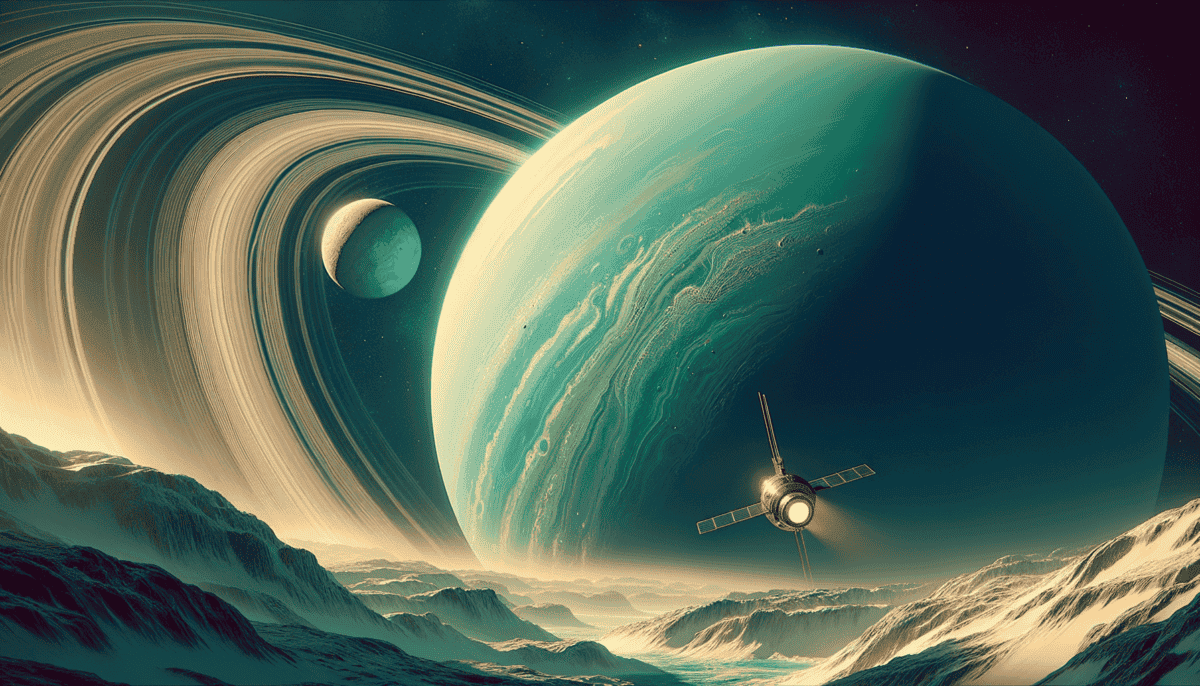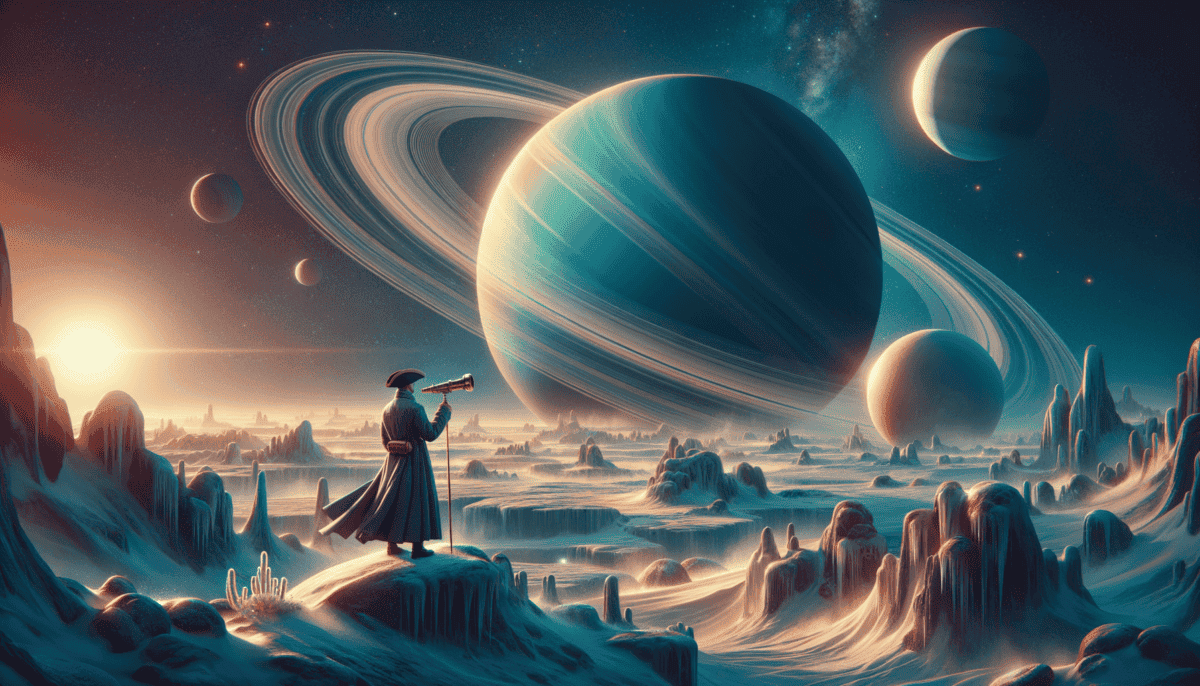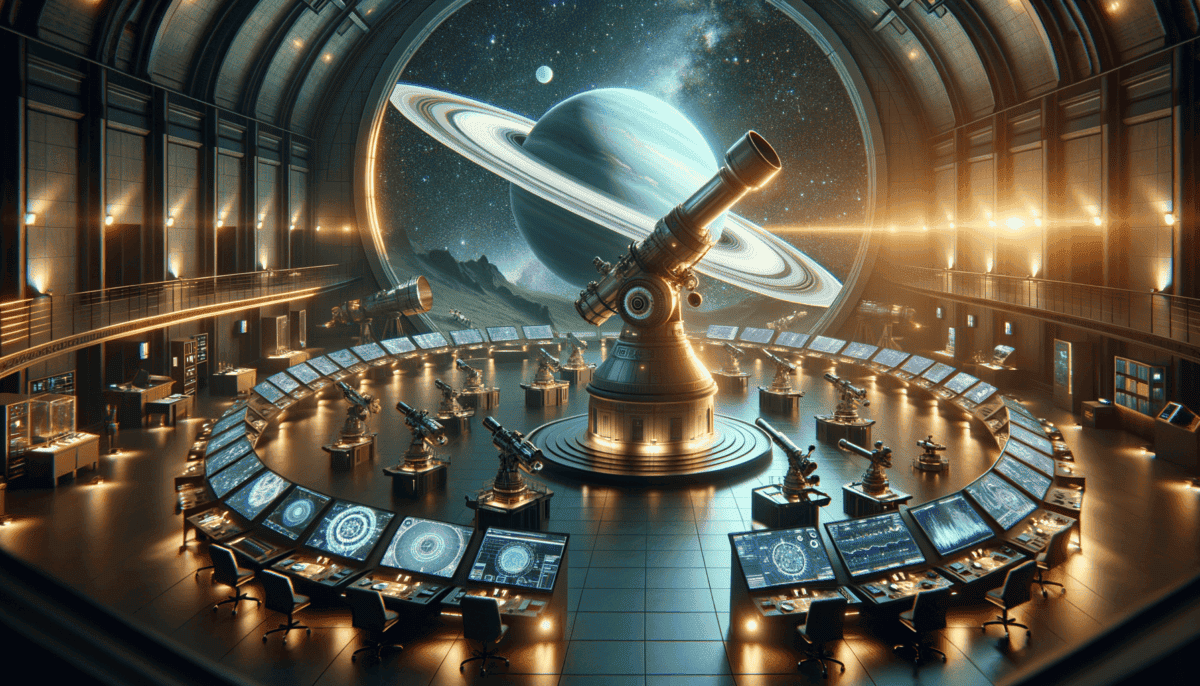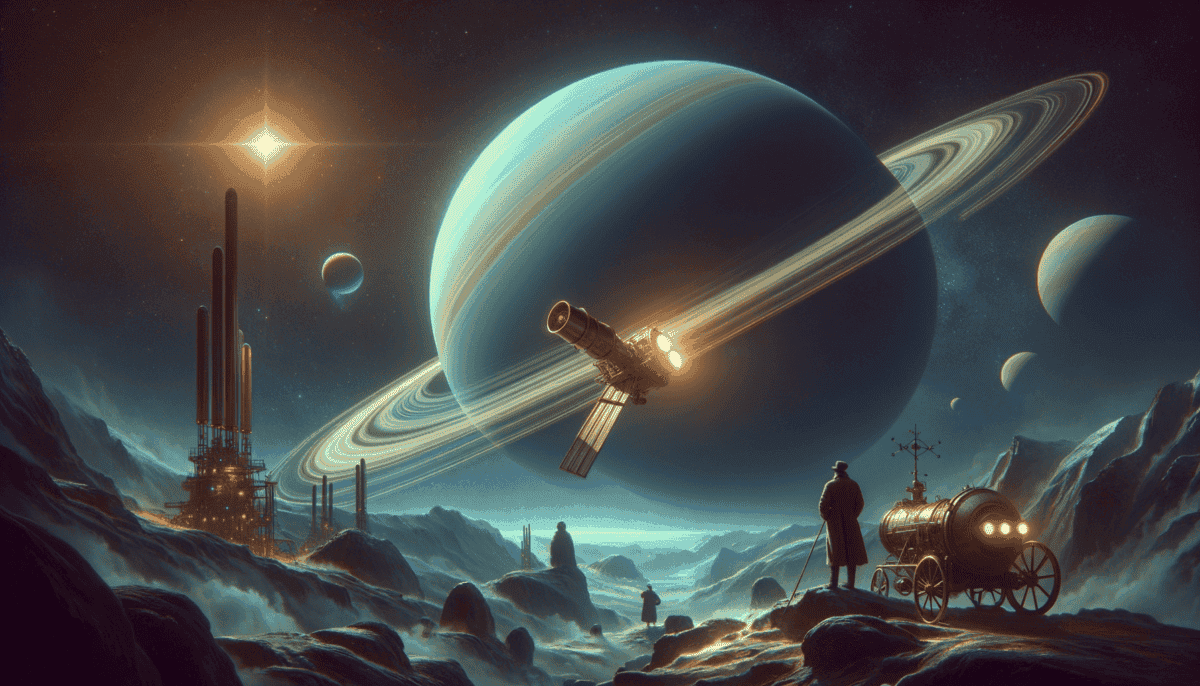The Accidental Discovery
On a chilly night in 1781, William Herschel sat at his telescope in Bath, England. The stars twinkled above like tiny diamonds. William wasn’t looking for anything special – he just loved watching the night sky.
Caroline rushed over. Together, they looked through the telescope at a small blue-green dot. It wasn’t like the other stars – it was bigger and had a different color.
“What do you think it is, William?” Caroline asked excitedly.
“I’m not sure,” William replied, scratching his head. “But it’s moving differently than a star should!”
From Music to the Stars
William wasn’t always a stargazer. He used to be a music teacher who played the organ! But he fell in love with the stars and built his own telescopes. His telescopes were special – they could see things other people’s telescopes couldn’t.
“Sometimes the best discoveries happen when we’re not looking for them!” – William would often say.
Night after night, William watched his mysterious blue-green dot. It moved slowly across the sky, unlike any star he’d seen before. Could it be something new? Something no one had ever seen?
A Big Surprise
William wrote to other scientists about what he saw. At first, he thought it might be a comet. But the more they looked, the more excited they got. This wasn’t a comet at all – it was a whole new planet!
Scientists all over Europe were amazed. No one had discovered a new planet in thousands of years! William became famous overnight. The king even gave him money to build bigger telescopes.
A Family of Stargazers
Caroline was just as excited as her brother. She helped him write down everything they saw. Together, they made maps of the stars and kept careful notes about their new planet.
“We’re making history,” William told Caroline one night as they watched Uranus through their telescope. “Just think – this planet has always been there, but we’re the first people to ever see it!”
• It was very far away
• It had a blue-green color
• It moved more slowly than other planets
• It was bigger than Earth
The discovery of Uranus showed that there was still so much to learn about our solar system. William kept watching the skies until he was very old, always hoping to find more surprises among the stars.
That night in 1781 changed everything we knew about our solar system. And it all started with a curious musician who loved to look at the stars. ⭐
A Planet Like No Other
The more scientists studied Uranus, the more they realized how special it was. This blue-green giant had many surprises in store!
The Sideways Planet
Most planets spin like a top, but Uranus is different. It lies on its side and rolls around the Sun! Imagine doing cartwheels around a track – that’s how Uranus moves through space.
“Uranus is the only planet that break-dances around the Sun!” – Kids at the Space Center often joke.
This silly way of spinning makes Uranus very special. It means that sometimes one end of the planet points right at the Sun, while the other end stays in total darkness!
The Color Mystery
Looking through a telescope, Uranus glows with a beautiful blue-green color. It’s like a giant robin’s egg floating in space! The color comes from gases in its air – mostly something called methane that acts like a blue filter.
• It’s four times bigger than Earth
• It has 27 moons
• A year on Uranus lasts 84 Earth years
• It has rings like Saturn, but they’re harder to see
Extreme Seasons
Because Uranus spins sideways, it has the strangest seasons in our solar system. Each season lasts 21 Earth years! That means if you lived on Uranus, summer vacation would be very, very long. ☀️
During summer, one half of the planet faces the Sun for 21 years straight. The other half stays in the dark, making it super cold. Then it switches!
A Very Cold World
“If you tried to visit Uranus, you’d need the warmest coat ever made,” explains Dr. Martinez. “It’s even colder than Neptune, which is further from the Sun!”
Scientific Puzzles
Scientists still have many questions about Uranus. They wonder why it spins sideways and why it’s so cold. Some think maybe a long time ago, something big crashed into Uranus and knocked it over!
“Every time we look at Uranus, we find something new to puzzle over,” says astronomer Jack Thompson. “It’s like a mystery book that keeps adding new chapters!”
Even with all our modern telescopes and tools, Uranus keeps surprising us. It’s teaching us that our solar system is more amazing than we ever imagined.
The sideways ice giant continues to dance its unique dance around the Sun, reminding us that sometimes the most interesting things in space are the ones that don’t follow the rules!
An Epic Journey Through Space
The year was 1977. Scientists had a big dream – to send a special robot called Voyager 2 to visit Uranus!
Getting Ready for Launch
The team worked hard to build a spacecraft that could survive such a long trip. They gave it special cameras, computers, and tools to study Uranus up close. It was like packing for the longest vacation ever!
“We packed everything Voyager 2 would need for its billion-mile journey,” smiled Engineer Maria Chen. “Even a special radio to talk to Earth!”
The Long Space Road
Zoom! On August 20, 1977, Voyager 2 blasted off into space. It flew past Jupiter and Saturn on its way to Uranus. Every day, it sent pictures back to Earth, like a space tourist sending postcards home.
• Traveled over 1.8 billion miles
• Took thousands of pictures
• Found 10 new moons around Uranus
• Discovered two new rings
Meeting Uranus
Finally, in January 1986, Voyager 2 reached Uranus! It was the first time anyone had seen the ice giant up close. Scientists jumped for joy when the first pictures arrived.
Surprising Discoveries
Voyager 2 found many surprises. It saw storms in Uranus’s clouds and weird magnetic fields that didn’t work like Earth’s. The spacecraft even discovered that some of Uranus’s moons had valleys deeper than the Grand Canyon!
“Every picture from Voyager 2 taught us something new,” says Dr. Park. “It was like opening presents on Christmas morning – each one was a wonderful surprise!”
A Special Moon Dance
The moons around Uranus put on quite a show for Voyager 2. Some danced in circles, while others moved back and forth like they were playing tag. One moon named Miranda looked like someone had taken pieces from different puzzles and stuck them together!
“Miranda is the strangest moon we’ve ever seen,” said Dr. Williams. “It has cliffs as tall as Mount Everest!”
Saying Goodbye
After its visit to Uranus, Voyager 2 continued its journey into deep space. It’s still out there today, sending messages back to Earth about what it sees.
Thanks to this brave little spacecraft, we learned more about Uranus in a few days than we had in 200 years of looking through telescopes. Voyager 2’s visit showed us just how amazing our solar system really is!
The spacecraft keeps flying further and further away, carrying a golden record with sounds and pictures from Earth. Maybe someday, far in the future, someone else will find it and learn about our wonderful journey to Uranus.
Inside the Ice Giant
Let’s dive deep into Uranus! This mysterious planet holds so many secrets inside its swirling blue-green clouds.
A Strange World
If you could peek inside Uranus, you’d see something amazing. Instead of having a rocky center like Earth, it has layers that look like an onion!
Layers of Mystery
• Small rocky core in the middle
• Ocean of icy water and ammonia
• Thick layer of gases on top
• Beautiful blue-green clouds outside
Super Cold Weather
Brrr! Uranus is one of the coldest places in our solar system. The clouds are so cold that they freeze into tiny ice crystals. ❄️
“The temperature on Uranus can drop to -224 degrees Celsius,” says Dr. Jones. “That’s colder than your freezer times 100!”
The Sideways Planet
Here’s something funny about Uranus – it rolls around the Sun like a ball! While Earth spins like a top, Uranus lies on its side. This makes its seasons super strange.
A Magnetic Mystery
Uranus has a special force field called a magnetic field. But it’s not like Earth’s! Our magnetic field comes out of the North and South poles, but Uranus’s magnetic field comes out of its sides!
“It’s like having a compass that points sideways instead of north,” explains Dr. Mike Chen. “We still don’t know why it’s so different!”
Dancing Winds
The winds on Uranus are super fast! They can blow up to 560 miles per hour. That’s faster than the strongest hurricane on Earth. ️
“These mighty winds create bands of clouds that circle the whole planet,” says Dr. Chen. “Sometimes we can even see giant storms appear!”
Hidden Treasures
Scientists think there might be oceans of diamonds deep inside Uranus! The extreme pressure could turn carbon into sparkly diamonds that rain down inside the planet.
There’s still so much we don’t know about this beautiful ice giant. Every new discovery brings more questions. What other secrets is Uranus hiding in its swirling storms and icy depths?
As our telescopes get better and we send more spacecraft to visit, we’ll keep learning more about this fascinating world that spins sideways through space.
Watching from Earth
Scientists today use amazing tools to study Uranus! Let’s see how they peek at this far-away planet.
Super Space Eyes
The Hubble Space Telescope floats high above Earth. It takes beautiful pictures of Uranus that show its blue-green color and stormy clouds. ✨
Team Space Work
Scientists from all over the world work together to study Uranus. They share their findings and help each other solve space mysteries!
“When we work as a team, we learn so much more,” explains Dr. Park. “It’s like having a giant puzzle where everyone adds their own piece!”
New Ways to Look
• Giant telescopes on mountains
• Special cameras that see heat
• Computer programs that make 3D models
• Radio dishes that listen to space
Weather Watching
Scientists keep track of storms on Uranus just like weather forecasters do on Earth! They’ve spotted huge storms bigger than Texas. ️
Ring Discovery
In 1977, scientists found something surprising – Uranus has rings! They’re dark and hard to see, but they’re there, circling the planet like tiny dark hoops.
“Finding the rings was like spotting a black cat at night,” says Dr. Reed. “We needed special tools to see them!”
Moon Watching
We keep finding new moons around Uranus! Right now, we know it has 27 moons. Each one is special and has its own name.
“The moons dance around Uranus like a cosmic ballet,” explains Dr. Park. “Some spin forward, some backward, and they all have different speeds!”
Computer Help
Scientists use powerful computers to understand what they see. These computers can show us what Uranus might look like up close.
They help scientists figure out things like:
– What makes the planet so blue
– How fast the winds blow
– What’s happening inside the planet
– Where storms might form next
Learning More Every Day
Even though Uranus is very far away, we learn new things about it all the time! Modern technology helps us see this mysterious planet better than ever before.
Scientists keep watching and studying, hoping to unlock more secrets about our sideways neighbor in space. Each new discovery brings us closer to understanding this amazing ice giant.
Dreams of Tomorrow
Space scientists have big plans for Uranus! Let’s discover what exciting adventures await this mysterious ice giant.
The Next Big Mission
NASA wants to send a special spacecraft to Uranus! This new explorer would be like Voyager 2, but much better. ✨
The Space Journey
The trip to Uranus takes a long time – about 13 years! That’s like waiting from when you start kindergarten until you’re in college.
“It’s a long journey,” explains Dr. Chen, “but worth every minute to learn about this amazing planet!”
What We Hope to Find
• What’s inside Uranus
• Why it spins sideways
• What makes its storms
• How its rings formed
Special Tools
The new spacecraft will carry super cool tools! It will have cameras that can see through clouds and machines that can “taste” the air around Uranus.
Moon Explorer
The spacecraft might also visit some of Uranus’s moons! Each moon is like a new world to explore.
Young Scientists
Maybe you’ll be one of the scientists who studies what we find! By the time the spacecraft reaches Uranus, today’s second graders could be space scientists.
“We need curious young minds to help us understand what we discover,” says Dr. Chen. “The future of space exploration belongs to you!”
Our Amazing Universe
Uranus has taught us so much since William Herschel first spotted it in 1781. From a tiny dot in a telescope to a fascinating ice giant, we keep learning more about this special planet.
As we dream about future missions and discoveries, remember that space exploration is all about curiosity and wonder. Every time we look up at the night sky, Uranus is out there, spinning sideways, keeping its secrets until we visit again.
Who knows? Maybe someday you’ll be the one to unlock new mysteries about our fascinating blue-green neighbor in space!






